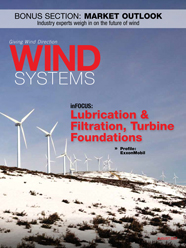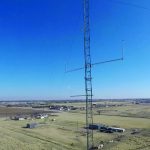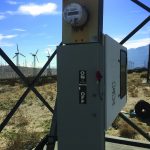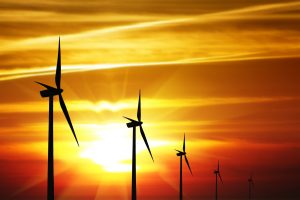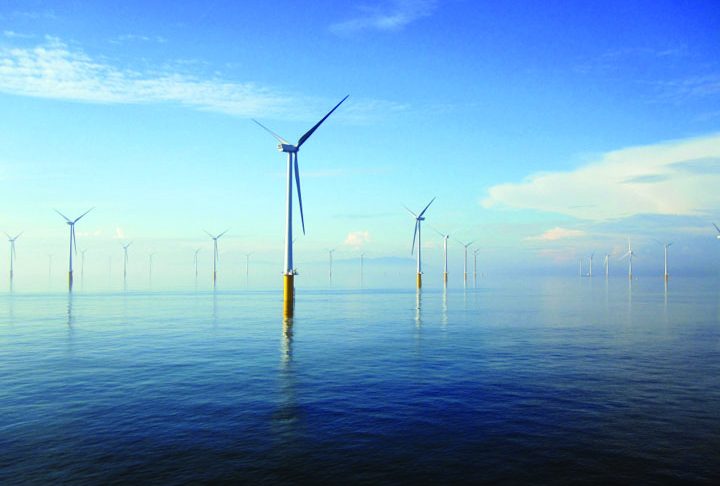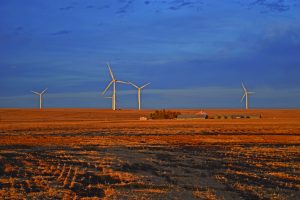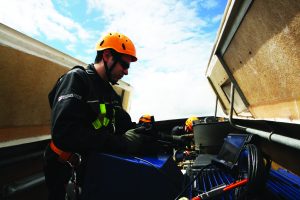The wind energy market boom is expected to continue in 2017 as the federal Production Tax Credit (PTC) drives new wind-project development and boosts the already lively O&M market.
In fact, the industry has seen so much growth that “wind-turbine technician” was the fastest growing job in the U.S. last year.
The past year saw the installation of 8.2 GW from new plants. Continued high growth in 2017 is expected, with the additional installation of 7.8 GW in wind energy, said Bruce Hamilton, director of Navigant Research’s energy practice.
This year’s growth will be driven principally by developers who are accelerating wind projects in order to take advantage of PTC subsidies, which will be gradually phased out by 2020. PTC credits in 2017 will be stepped down to 80 percent of 2016 values, 60 percent in 2018, and 40 percent in 2019, Hamilton said.
In a study that Navigant conducted for AWEA, developers and OEMs were interviewed for their near-term plans and reported that many of their planned projects for the 2021-2023 timeframe are being pushed forward in order to be eligible for high PTC subsidizations, Hamilton said.
“We saw a lot of projects accelerated to qualify for the full PTC, which caused a spike in wind installations in early 2017,” said Hayden Baker, a partner at Sullivan & Worcester. “But there remains a robust pipeline for this year; we expect to see several more sizeable projects announced in the second half of 2017.”
PTC Safe Harbor Clause
A vital component of the PTC that’s driving the boom in growth is the 5 percent safe harbor clause. Wind projects are eligible for the current-year PTC subsidy if a minimum of 5 percent of the project’s total capital cost is incurred before the end of that year, Hamilton said. Projects also must comply with the four-year rule, which says that project construction must be completed within four years after starting.
“Virtually all new projects we are seeing in the market are taking advantage of the ‘begin construction’ rules in order to capture the full, rather than the reduced, PTC amount,” said Ed Einowski, renewable energy project finance and development partner at Stoel Rives.
Because one of the largest expenses invested in a wind project are the turbines, one of the ways to meet the 5 percent requirement is to purchase wind turbines before the end of the current calendar year. This has generated a booming market for turbines, Hamilton said. This safe harbor market was responsible for the 10 GW of turbines ordered last year, which qualified for 100 percent of the PTC that’s eligible to be installed any time during the next four years. This year, Navigant predicts the turbine market will drop somewhat because purchases this year will qualify for only 80 percent of the PTC credit.
Navigant predicts the high growth of the wind market will continue for the next four years as more projects are accelerated to take advantage of the PTC. In fact, Navigant predicts that wind-energy growth will increase every year and peak in 2020, which will be the year that accelerated projects — which entered the pipeline in 2016 with a 100 percent subsidy under the PTC —will be required to be completed under the four-year rule.
Increasing state RPS requirements and improved transmission also will contribute to this increase in growth, Hamilton said. Beginning in 2020, after the PTC phases out, the growth will subside over several years. This fall-off will occur as additional projects, whose development was accelerated in order to be eligible for PTC subsidies, are completed.
However, Meghan McIver, business development associate at Apex Clean Energy, sees a rosy long-term forecast for the wind market after the PTC phase-out, especially for O&M.
“Many of the long-term projections forecast wind as the largest source of electricity in the U.S. for a number of reasons, including drastically falling costs,” she said. “This means even after the PTC phases out, wind O&M will likely continue to see new customers.”
Long-Term Growth
Bruce Bailey, vice president of Renewables in UL’s energy and power technologies division, said he also sees long-term growth in the wind market after the PTC has expired.
“The PTC makes wind cheaper for customers and was very important in giving wind a shot in the energy markets when the playing field wasn’t level,” he said. “In a world of much cheaper wind-energy prices and market acceptance, the need for the PTC to promote wind is waning.”
Whether the need for the PTC is waning, many wonder how the results of the recent presidential election and the changing political landscape in Washington will affect the U.S. wind-power industry. At the May 2017 AWEA Wind Power Conference, the AWEA policy committee concluded that the new administration is not targeting renewable energy. This was confirmed by U.S. Treasury Secretary Steven Mnuchin, who, during his nomination hearing, said the current phase-out of the PTC will not change. Further, many of the predominantly windy states, which are led by Republican governors and legislators, won’t want to change the timeline of the PTC phase-out because that could undermine those states’ economies and jobs.
“Although the Clean Power Plan is pretty much dead, it is encouraging to see that states are already proceeding with their own policies as if those federal requirements are still in effect,” Hamilton said.
However, with the elimination of the Clean Power Plan, coal-plant retirements will happen more slowly, and initially will be down by 30 percent from what was predicted a year ago, he said.
But states are expected to pick up their activity in response to the federal government’s withdrawal from the Paris Climate agreement and its killing the Clean Power Plan. Subsidies for wind-project development will increasingly come from individual state RPS requirements. Many states are raising their RPS, which will be a major force in driving wind-energy development after the PTC phase out in 2020, Hamilton said.
More Investment Money
In addition to increased attention to renewable energy at the state level, businesses are showing interest in using renewable energy sources for their electricity needs.
“In spite of the current administration, people are going for renewables,” said Marlene Motyka, U.S. Global and Renewable Energy Leader for Deloitte. “Climate change and green energy have moved beyond politics; it’s past the tipping point. Sixty-one percent of businesses are demanding that their company acquire a portion of their electricity from renewable sources. That won’t stop regardless of what’s happening on the political front.”
This strong interest in renewable energy by businesses has prompted vigorous U.S. investment in wind energy.
“The administration’s withdrawal from Paris and reversal on the Clean Power Plan left little doubt about the trajectory of federal policy under (President Donald) Trump, but as a practical matter those measures were not driving wind development or investment,” Baker said.
“There is currently a great deal more investment money seeking wind projects than there are wind projects available,” Einowski said.
While most of the explosive growth in the U.S. wind-power industry has occurred in the onshore wind market, new offshore wind markets are opening in several key states. In 2016, Massachusetts passed legislation that requires procurement of 1,600 MW offshore wind by 2030. In 2017, New York voted to approve the nation’s largest offshore wind farm, a 90-MW development 30 miles southeast of Montauk. This project is part of the state’s mandate to produce 50 percent of the state’s electricity from renewable energy by 2030.
Construction and O&M
The high growth of the wind market over the next four years will drive the creation of many new jobs in the wind-power industry. Navigant predicts employment in the wind-power field will reach 248,000 in 2020, up from 180,000 in 2017. These new jobs will be in all aspects of the wind-power industry, including manufacturing, construction, and operations and maintenance, Hamilton said.
The biggest increase in employment in the wind-power industry will be in construction and operations and maintenance, accounting for 114,000 of new jobs. O&M will see an increase of 62,000 jobs while construction jobs will increase by 84,000. Manufacturing jobs will see a somewhat smaller increase of 33,000, Hamilton said.
Navigant’s wind-market forecast, prepared for AWEA, notes that the project pipeline at the beginning of 2017 was 28 percent larger than the pipeline at the beginning of 2016. As of January 2017, 9.4 GW were under construction, and 11.6 GW were in advanced development.
The employment boosts over the last year were so high that wind-turbine technician was the fastest growing profession in the country last year, according to the U.S. Department of Labor.
“Wind-turbine operations and maintenance represents a growing sector of the industry, and the future seems even brighter as companies are bringing more wind projects online before the PTC wanes,” McIver said
Mergers and Consolidations
The high growth and maturation of the wind market is driving consolidations and mergers in O&M, which has traditionally been handled by independent service providers. These companies have not usually been affiliated with OEMs or the owners of wind plants. For example, during 2015-2016, Vestas acquired several independent service providers, including UpWind Technologies, as well as Availon.
“The industry overall has seen a number of buyouts of smaller operations and maintenance companies,” McIver said. “These strategic partnerships broaden the offerings of various O&M providers, creating a streamlined contract and process for customers. Instead of working with different businesses for their various needs, customers are now seeing one-stop service providers.”
Along with buyouts, wind-power growth is driving the creation of new business offering specialized services. One example is Strat Aero, which uses unmanned drones to perform turbine-blade maintenance inspections. Using unmanned aerial vehicles and advanced proprietary software, the company inspects up to eight turbines per day, which is significantly more turbines compared to the two-per-day of conventional manual inspection methods.
“Throughout the wind-energy industry, drones are becoming more prevalent for site and blade inspection because they offer clear views of every angle of the turbines,” McIver said. “Using drones improves our efficiency and enables us to better ensure the health of our turbine blades.”
R&D Focus
Other areas of the wind-power industry are the focus of intensive R&D efforts.
One such focus is the use of “smart” data analytics to provide more accurate forecasts of wind, allowing more wind power to be integrated into the existing power grid. This technology helps address fluctuations in wind production that create the need for backup power. When these backup sources are conventional power plants, it’s expensive and inefficient to keep these plants idling. Software developed by the National Center for Atmospheric Research (NCAR) in Boulder, Colorado, can generate accurate forecasts of how much power to expect from a wind farm in 15-minute increments, for up to seven days, allowing more efficient utilization of backup power plants.
According to UL’s Bailey, “Everything is getting smarter, thanks to inexpensive sensors, big data and data analytics, advanced controllers. Smart means better energy productivity, longer component lifetimes, and, consequently, improved economics.”
For example, GE uses big data and analytics to help predict turbine failures and also to help decide when wind can be best used in the market, said Kimberly Brown, head of GE’s product marketing for renewable energy digital solutions.
One example is predictive monitoring, she said. This involves gathering vibration data from sensors on wind turbines.
“We can model analytics and look outward and say, based on the trends, we’re seeing potential escalation and can predict gearbox failures,” she said.
Big data also can be used to make decisions on forecasting and bidding into the market, Brown said.
Taller Tower Challenge
In addition to big data, R&D is focused on taller towers
“The wind resource is better the higher you go, but taller towers are more expensive so you have a tradeoff,” said Daniel Laird, director, National Wind Technology Center (NWTC), NREL.
One solution is called “Hexcrete” wind turbine towers. The towers are assembled from precast concrete panels and columns that are tied together on-site by cables to form hexagon-shaped cells. The cells can be stacked to form towers as high as 140 meters, said Sri Sritharan, Professor, Wilkinson Chair in Engineering, Iowa State University, College of Engineering, who is developing the product.
“Taller towers have benefits in both the wind-rich regions and regions like the Southeast where renewable energy production is fairly low,” he said. “The Hexcrete technology will facilitate the use of tall towers throughout the nation as it eliminates transportation logistics and other challenges that are associated with building them.”
Taller wind-turbine towers will be crucial in expanding wind power nationwide, enabling wind energy production in all 50 states, according to studies by the U.S. Department of Energy’s National Renewable Energy Laboratory, based in Golden, Colorado.
Overall, these R&D efforts are expected to help keep the industry competitive, even after the PTC expires.
“Renewables and wind specifically are born of innovation and change,” Brown said. “What makes it special is the industry understands the need for change and innovates change. What’s really unique is the rate of change.”
















